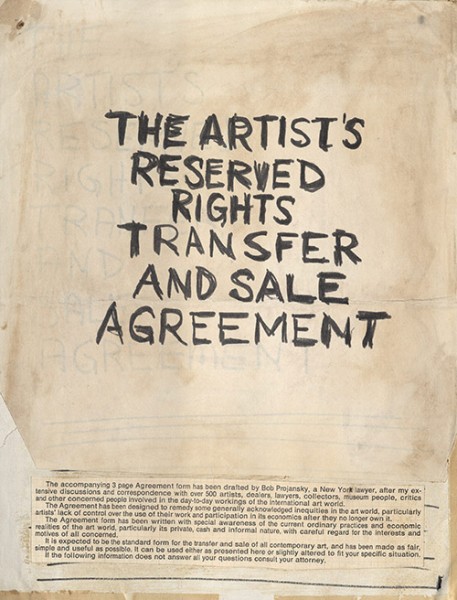
Richard Serra’s Tilted Arc destroyed on March 16, 1989.
© Jennifer Kotter. Courtesy Jennifer Kotter.
Canceled:
Alternative Manifestations
& Productive Failures
Freedman Gallery, Albright College
October 10–November 17, 2013
Lecture by Guest Curator Lauren van Haaften-Schick & Sergio Muñoz Sarmiento
Thursday, October 10, 4pm, Klein Hall
Opening reception: Thursday, October 10, 5–7pm
The Freedman Gallery
Center for the Arts
Albright College
Reading, PA
www.albright.edu/freedman
Guest curated by Lauren van Haaften-Schick
Canceled: Alternative Manifestations & Productive Failures considers a selection of historic and contemporary canceled exhibitions, and the secondary projects that artists and curators created in response to, or in place of, these foreclosed efforts. Initially presented at the Center for Book Arts in New York, Canceled highlights the book form and printed matter as a crucial means of disseminating artworks, documentation and information on a wide scale, potentially in ways that are more historically accessible than the intended exhibition would have been.
The materials in Canceled also include correspondence, photographs, video, and web presences that serve to document the process and politics of a cancellation, stand as an alternative manifestation of an exhibit, act as a critique of prohibitive forces, and may be an admission and exposition of an ultimately productive failure. In some cases, alternate venues and curators take a direct hand in ensuring other outlets for controversial artworks. At other times, artists will choose to opt out, subverting accepted institutional power structures. By utilizing non-traditional means of dissemination and exhibition, these artists and curators have found alternative routes through which the politics surrounding the presentation and creation of art become at least as relevant as the work itself.
A catalogue has been produced in conjunction with the exhibition.
Exhibitions and artists’ projects:
– Seth Siegelaub, publications, 1968
– Manifesta 6, 2006
– Wallace Berman, Ferus Gallery, 1957
– Hans Haacke, Solomon R. Guggenheim Museum, 1971
– Guerrilla Girls, Do women have to be naked to get into the Met. Museum?, Billboard for the Public Art Fund, 1989
– Jill Magid, Article 12, commission for the AIVD, 2004–2008; Becoming Tarden, confiscated from Authority to Remove, Tate Modern, 2009
– David Wojnarowicz, A Fire in My Belly, censored from the Smithsonian Institution, 2010
– Illegal America, Exit Art, 1982
– Richard Serra, Tilted Arc, 1981–1989
– Christoph Büchel, Training Ground for Democracy, Mass MoCA, 2006
– Patrick Cariou, Yes Rasta, Celle Gallery; Richard Prince, Canal Zone, Gagosian Gallery, 2008
– Takis, removal of sculpture from the Museum of Modern Art, 1968; The Art Workers Coalition, 1969
– Temporary Services, Why the Exhibit Was Canceled, 2001
– Brendan Fowler, BARR tour, 2008
– Bas Jan Ader, In Search of the Miraculous, 1975
And others.
Associated publications, artworks, and documentation:
Bas Jan Ader, Greg Allen, the Art Workers Coalition, Wallace Berman, Christoph Büchel, Martha Buskirk, Patrick Cariou, Shu Lea Cheang, Dexter Sinister, Exit Art, Brendan Fowler, the Guerrilla Girls, Hans Haacke, David Horvitz, Douglas Huebler, Jonathan D. Katz, Jill Magid, P.P.O.W., Primary Information, Richard Prince, Seth Siegelaub, Richard Serra, Temporary Services, Lawrence Weiner, Werkplaats Typografie, Marion van Wijk and Dalstar, Amy Wilson, David Wojnarowicz, and many others.
Canceled: Alternative Manifestations and Productive Failures
Freedman Gallery, Center For the Arts
Albright College, Reading, PA
October 10–November 17, 2013
The Oresman Gallery
Smith College, Northampton, MA
February 2014
Lauren van Haaften-Schick is a curator, artist and writer from New York. Her current interests concern the economic and legal factors that influence the conceptual and material manifestations of art. She is currently developing Non-Participation, a collection of artists’ letters of refusal, to be published by Half Letter Press. Presentations in 2013 include the CAA Conference in New York, the Art Law Program, and the NY Art Book Fair. She was the founding director of Gallery TK in Northampton, MA, and AHN|VHS gallery and bookstore in Philadelphia. www.laurenvhs.com
To learn more about the exhibition, please visit www.albright.edu/freedman.
The Freedman Gallery is located in the Center for the Arts at Albright College on 13th and Bern Streets, Reading. For more information or disabled assistance, please call 610 921 7715.
Exhibitions and programs in the visual arts at Albright College and The Freedman Gallery are generously supported by The Silverweed Foundation in honor of Doris C. Freedman, the Pennsylvania Council on the Arts and its partner, the Berks Arts Council, and the Pennsylvania Department of Community and Economic Development.
Albright is a nationally ranked, private college with a rigorous liberal arts curriculum with an interdisciplinary focus. The College’s hallmarks are connecting fields of learning, collaborative teaching and learning, and a flexible curriculum that allows students to create an individualized education. Albright College enrolls more than 1,650 undergraduates in traditional programs, 800 adult students in accelerated degree programs and 100 students in the master’s program in education.











